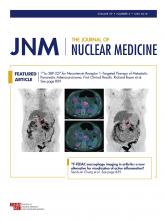TO THE EDITOR: We read with great interest the article by Calais and colleagues, “Comparison of 68Ga-PSMA-11 and 18F-Fluciclovine PET/CT in a Case Series of 10 Patients with Prostate Cancer Recurrence” (1). We consider it important that the data presented be interpreted appropriately.
The authors’ enthusiasm is admirable; however, claiming that this was a “head-to-head comparison” and concluding that the findings “suggest a superior detection rate” for 68Ga-PSMA strikes us as inappropriate, overstated, and misleading. By definition, “head-to-head” should only be used to describe a comparison of 2 entities directly against one another and subject to the same rules and conditions. In medical research, this is typically a randomized, controlled clinical trial. In our opinion, it is never appropriate to apply this description to a series of 10 case reports, with biases and methodologic concerns that include:
Patient selection bias: 10 patients were retrospectively selected from a large 288-patient prospective study, with the authors noting “Patients likely had negative 18F-fluciclovine PET/CT results and were therefore referred for 68Ga-PSMA-11 PET/CT.”
Sequencing bias: the 18F-fluciclovine scan was always performed first.
Time interval between scans: up to 4.2 mo.
Prescan prostate-specific antigen (PSA) levels: in all 10 patients, the PSA level was greater before the 68Ga-PSMA, scan, with an important difference in the mean levels; the PSA range before 68Ga-PSMA scanning was twice that before 18F-fluciclovine scanning.
18F-fluciclovine image acquisition: performed at multiple sites and not standardized.
Image interpretation: the “experienced” reader was not masked; 68Ga-PSMA imaging included a diagnostic CT examination, 18F-fluciclovine PET/CT did not.
Finally, pathologic correlates, considered the standard of truth, were not available to rule out false-positive results with 68Ga-PSMA, as have been reported with all PSMA agents currently under investigation (2).
Axumin (fluciclovine F 18) is approved by the U.S. Food and Drug Administration as the first 18F-labeled PET imaging agent for localization of recurrent prostate cancer. The safety and efficacy of 18F-fluciclovine have been reported in almost 600 patients, across a broad, multinational experience (3). In contrast, all current PSMA agents are currently considered investigational. The detection rate of 18F-fluciclovine is 68%, not 20%, as suggested by Calais et al. (1). Importantly, even in patients with a low PSA (<0.79 ng/mL), the detection rate for 18F-fluciclovine is more than 40% (3). Also, an ongoing National Institutes of Health–funded, randomized, controlled clinical trial (NCT01666808) has reported the utility of 18F-fluciclovine in postprostatectomy radiation therapy planning, with augmentation of the target volumes in 30 of 41 patients (4). Interim data from the prospective FALCON (NCT02578940) trial demonstrated a revision in therapeutic management after 18F-fluciclovine imaging in 52 of 85 (61.2%) patients (5).
As suggested by Calais and colleagues, 18F-fluciclovine is the reference standard for PET imaging in prostate cancer in the United States and is now included in the American College of Radiology Appropriateness Criteria as “usually appropriate” for follow-up in prostate cancer patients’ postprostatectomy and after nonsurgical local and pelvic treatments, when there is clinical concern for residual or recurrent disease (6).
Although there is a need to evaluate the relative merits of different imaging tools in men with prostate cancer, such studies should be conducted with scientific rigor. We remain confident in and encouraged by the documented performance of 18F-fluciclovine at this time. We are also very optimistic about the future potential of several PSMA agents, currently under investigation, and the role of advanced PET imaging, in general, for patients with prostate cancer.
Footnotes
Published online Feb. 23, 2018.
- © 2018 by the Society of Nuclear Medicine and Molecular Imaging.







